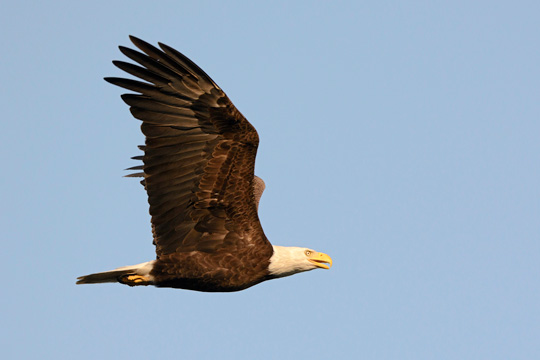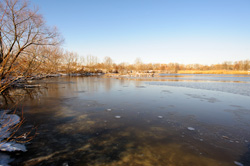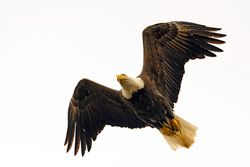 As I write this, the Philadelphia Eagles could actually win the NFC East, which makes every Sunday an emotional hazard. For my emotional self-defense, I hedge with other, more reliable activities—like picking up a pair of binoculars and checking out some real Philadelphia eagles. The eagles that have actual wings and talons start building or rehabbing their nests in December in order to have them ready for eggs in January. On land, everything might be cold and dormant, but if the water isn’t frozen, bald eagles can fish. That’s enough to keep them—as well as gulls, cormorants and other waterfowl—active and visible in Northeast Philadelphia, at the mouth of Pennypack Creek, also known as Pennypack on the Delaware.
As I write this, the Philadelphia Eagles could actually win the NFC East, which makes every Sunday an emotional hazard. For my emotional self-defense, I hedge with other, more reliable activities—like picking up a pair of binoculars and checking out some real Philadelphia eagles. The eagles that have actual wings and talons start building or rehabbing their nests in December in order to have them ready for eggs in January. On land, everything might be cold and dormant, but if the water isn’t frozen, bald eagles can fish. That’s enough to keep them—as well as gulls, cormorants and other waterfowl—active and visible in Northeast Philadelphia, at the mouth of Pennypack Creek, also known as Pennypack on the Delaware.
 Pennypack on the Delaware, home of the Philadelphia eaglesThe football Eagles last won an NFL championship in 1960, right about when bald eagle populations were bottoming out from hunting and, more devastatingly, the insecticide DDT, which weakened their egg shells so that the parents crushed their babies before they could even hatch. With DDT banned in 1972, the stage was set for the return of the eagles. In 1973, the Pennsylvania Game Commission started releasing young birds from Canada. Bald eagles now breed on their own across the state, and even on the Delaware River, but it took a little help to get them there.
Pennypack on the Delaware, home of the Philadelphia eaglesThe football Eagles last won an NFL championship in 1960, right about when bald eagle populations were bottoming out from hunting and, more devastatingly, the insecticide DDT, which weakened their egg shells so that the parents crushed their babies before they could even hatch. With DDT banned in 1972, the stage was set for the return of the eagles. In 1973, the Pennsylvania Game Commission started releasing young birds from Canada. Bald eagles now breed on their own across the state, and even on the Delaware River, but it took a little help to get them there.
The same is true for Pennypack on the Delaware. The land had long belonged to Fairmount Park (now part of the Parks and Recreation Department), but a lack of infrastructure and an unsanctioned fence erected by neighboring prison facilities kept the public out. According to Clyde Croasdale, who was vice president of the Friends of the Pennypack Park in the early 1990s, it took a sustained advocacy effort to reclaim the land for the park. That effort culminated in the official opening of Pennypack on the Delaware in 1998.
On a crisp Sunday morning, I headed out to see the park and the eagles for myself. A light mist clung to the surface of the Delaware as I walked the path along the river. Ring-billed gulls kept me company from the air. In the past, I had come to the park to check out great cormorants hanging around the buoys in the river, but this time I followed the paved path back inland a little to a marshy basin.
 The Pennsylvania Game Commission has posted red warning signs to keep us from getting too near the eagles and spooking them, but this was still plenty close to see one of the pair hanging out in their nest. Numerous songbird nests were tucked into trees along the path, but the eagles had built theirs with a commanding view in a tall white sycamore, easily visible above the reeds as we rounded a berm to our left and approached the opposite side of the basin. Bald eagles don’t need to hide.
The Pennsylvania Game Commission has posted red warning signs to keep us from getting too near the eagles and spooking them, but this was still plenty close to see one of the pair hanging out in their nest. Numerous songbird nests were tucked into trees along the path, but the eagles had built theirs with a commanding view in a tall white sycamore, easily visible above the reeds as we rounded a berm to our left and approached the opposite side of the basin. Bald eagles don’t need to hide.
No other bird looks like a bald eagle, but I’m so used to its depictions—on money, Muppets, football uniforms—that I had to remind myself that it was the real thing. Our founding fathers made this majestic white-headed raptor with a brutal yellow beak our national symbol for good reason. Nothing else in the Philadelphia sky radiates such power and dominance. Go see for yourself. You’ll have something to celebrate no matter what happens in the playoffs.
Resources
Bernard Brown is an amateur field herper, bureaucrat and founder of the PB&J Campaign, a movement focused on the benefits of eating lower on the food chain.
Photos by Christian Hunold.










